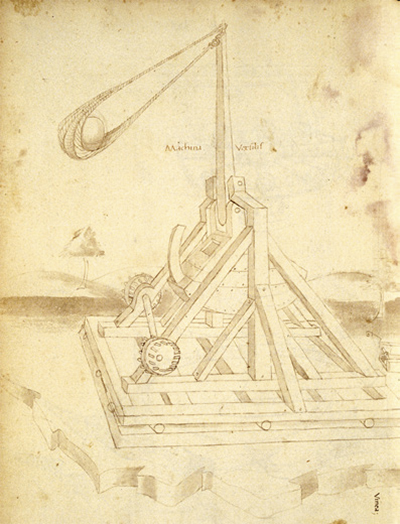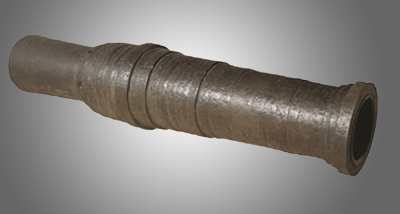Siege artillery: giants of iron and monsters of fire
To capture a town or fortress, the combatants used a military tactic called siege.
At the beginning of the 15th century, two types of artillery were used for these operations:
- Tension and torsion artillery, which consisted of wood-framed structures that used mechanical force to throw stone cannonballs. These spring, torsion or counterweight engiens such as the catapult were operated by highly specialised engineurs, the forebears of our present-day engineers.
- Gunpowder artillery, which consisted of cannons that used energy supplied by the combustion of gunpowder to shoot large stone cannonballs. Often made of wrought iron and comprising elements assembled using a process called tonoille (akin to how barrels were made), these weapons could be very large. Between 1409 and 1411, the Duke of Brabant, Antoine de Bourgogne, commissioned the construction of a bombard that weighed over 35 tonnes.
Gradually, gunpowder artillery became more widely used and supplanted tension and torsion artillery, the last machines of which disappeared in the first half of the 16th century
Zoom
Artillery : a time of experimentation
In the middle of the 15th century, experimentation for the purpose of developing campaign artillery grew.
In Burgundy around 1445, a series of trials documented in the Livre d’artillerie (Book of Artillery) as well the Veuglaire of Neuchâtel bear witness to the research. They aimed to improve the strength and range of the cannonball by modifying the proportions of the weapons.
Shortly afterwards, attention was focused on the nature of projectiles. New canons were invented, the serpentines, which were small calibre weapons that could shoot cannonballs of lead and iron, like those described in the Burgundian archives and found on the battlefield of Bosworth (1485) in England. This lighter artillery could be easily used on the battlefield.
Rare technical treatises such as the Livre du secret preserved traces of this knowledge that had been acquired through practice. They also recorded the manner of loading, directing and shooting the weapons.


















